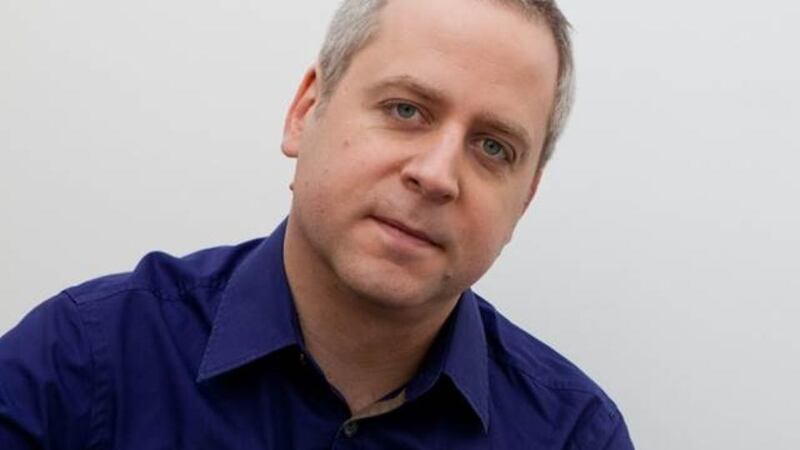The classical pianist Jeremy Denk is sitting in the window seat of a New York cafe. Outside the snow from Storm Jonas is melting, and our midday meeting raises the question of whether it is time for late breakfast or early lunch. Denk is in Manhattan briefly before another tour. He is used to being in such in-between states.
We are not talking about music, however, but maths. Denk excitedly recalls his childhood experiment with the Mandelbrot set, a set of numbers that, when mapped, produces an image of self-replicating patterns, which he succeeded in programming on an Apple IIe computer.
“You take a plot of numbers and you do an operation on them, and either they go off to infinity or they stay where they are. You put a dot to all the ones that stay where they are and you don’t put a dot if they go off to infinity. This boundary between the places that go off to infinity and the places that stay is very – infinitely – intricate and beautiful. As a kid I was obsessed with that.”

Years later, when he came to playing Bach's Goldberg Variations – the final piece on his forthcoming programme at the National Concert Hall in Dublin – the idea of the Mandelbrot set came back to him. "The math intervals, the symmetry of everything, the constantly redesigning around the same blueprint, the intricacy, the endless patterns of order . . . it's a completely different way of thinking about infinity, which is a deep desire in all of us."
Later he talks about the piece in terms of DNA. “Each variation is like DNA because the harmony is always the same but the flesh is different. It’s like you’ve been looking at this for an hour and then at the end you suddenly see a familiar face.”
No contradiction
This relationship between maths, science and music (and his talent for describing it) is not contradictory to him. After growing up in New Mexico, and skipping grades due to his proficiency in maths, he graduated from Oberlin College in Ohio with a double major in chemistry and piano, although he says “science would have been a disaster for me”.
“It’s funny, at Oberlin I began to hate the science of things and became very drawn to the English side: the more narrative, writerly form [of music], its grammar or metaphor.”
It was during this time, too, that he started thinking about “musical ideals” and encountered the Hungarian pianist György Sebök, who would become his mentor.
“I started thinking, what is music about? Is it telling stories? Achieving perfect translation of the score? What is it for? What are we doing?”
Denk has taken some of these musings into a blog called Think Denk. It might seem academic to analyse music, but he sees it as akin to “someone taking an engine apart to see how it works. It’s not intellectual to do that, it’s actually just curious.”
The blog led to a New Yorker article, "Every Good Boy Does Fine", and a subsequent book deal. The book – part music analysis, part memoir, and due for publication next year – expands on the subject of piano lessons and the intimate relationship between a music teacher and pupil. Denk himself was sent to piano lessons because he needed an outlet, being by his own admission "an intense, emotional child".
“My teachers thought I should have some extracurricular something or other; maybe today someone would give you a prescription.”
The Sebök factor
The way he talks about Sebök, his teacher at Oberlin, goes beyond what one might assume of a teacher-student relationship. “He was a vivid and powerful guru figure, with his own failings, kind of a Yoda.”
Denk speaks of being “under his spell”, coming out of masterclasses “shell-shocked”. We talk of the teacher’s ability to change a “worldview”, or to point out the one tiny, limiting facet of the student’s playing, even psyche, which releases everything. The relationship can be closer to that of a therapist, with much more imparted than how to play the keys. “The music isn’t the notes, it’s between the notes,” he says, quoting Sebök.
He recalls one particular session where Sebök played a Beethoven piece, one Denk had dismissed as "garbage", and suddenly the entire thing opened up. "There was something about just the sequence of the chords and the way that they happened in time, they opened and closed, it didn't seem like he was trying to do something that wasn't there, he was just doing, riding the thing."
This seems like a lesson in what people might call mindfulness. “Yeah, he talked a lot of Rubinstein too, saying there were only three or four times in his life he felt he was there in the moment.”
It’s an idea that’s important, too, in the “very fragmented” life of a travelling musician: that of finding the centre of gravity in limbo, the infinite in the patterns of Bach or, as Denk beautifully writes elsewhere, attempting to “probe eternity” in the time it takes to play the final movement of Beethoven’s last sonata. For Denk, music is a structuring principle as well as everything else.
“It’s hard to keep a sense of a continuous life running from place to place. I sat down this morning, feeling weird to be back in this city; I started playing Bach and the world arranged itself around the music.”
- Jeremy Denk performs Bach's Goldberg Variations, Mozart's Rondo in A minor, K 511 and Beethoven's Piano Sonata No 30, Op 109 on February 4th at the NCH, Dublin. nch.ie











